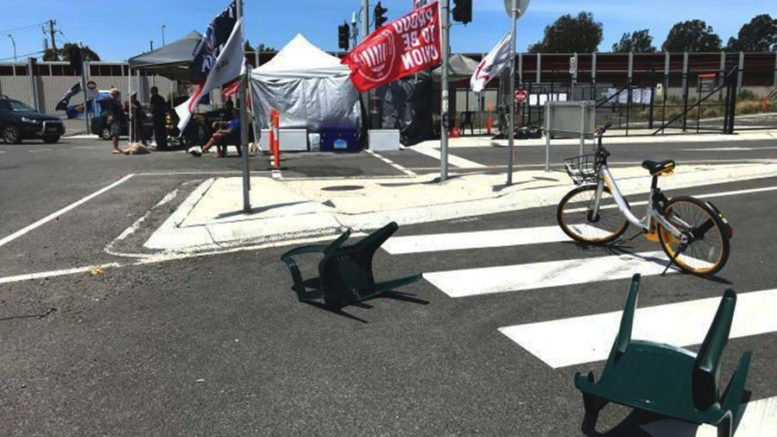Contributed by a member of the Media Arts and Entertainment Alliance
Yesterday (12 December 2017), Supreme Court Justice Michael McDonald ordered unions to lift the blockade at Webb Dock on Melbourne’s Waterfront. He said that the “balance of convenience” overwhelmingly proved that the strike action had been “coordinated and encouraged by union officials”.
This is extraordinary, because this is a decision made on hearsay and not the weight of evidence. It seems that the closest it came to using evidence, is the presence of union flags and memorabilia at the site. This is not much to go on.
Justice McDonald did add that there is a strong inference that the “MUA has outsourced to other unions, coordinated by the Victorian Trades Hall Council, the task of maintaining an illegal picket,” and that the “conduct of the picket has been characterised by a high degree of organisation”. This too seemed to be based on the acceptance of hearsay, rather than hard facts.
Suspicions that the federal government have weighed in behind the scenes, might prove to be justified. Justice McDonald’s order coincides with the unveiling of a campaign nationally and in Victoria to attack the Labor opposition, while at the same time pressuring the Labor leadership to intervene against the unions and ensure that the community blockade, which has stranded 1,000 shipping containers, is lifted.
The order names that Maritime Union of Australia (MUA), which had already received an injunction to go no closer than 100 metres of the site. This time the Construction Forestry Mining and Energy Union (CFMEU) and Trades Hall Council secretary, Luke Hilakari, were given the same order.
All were accused of “outsourcing” the dispute to “a self-styled group of ‘hard’ campaign activists coordinated by the Victorian Trades Council”.
The concept of a community assembly has evolved as a means where community support can be materialised, through community involvement. Community activism exists around a multitude of causes, whether it be over specific government policies, a demand for a change, over an environmental issue such as the Adani mine, or reaction to what is considered an inappropriate local development project.
Community campaigns invariably gravitate towards restricting the operations of a business or a government department. This is one of the few weapons that community activity can use to be effective, particularly when there is only a small window of opportunity to act.
There is also a history of community activity being linked to industrial disputes. A stand out is the MUA’s Patricks dispute of 1998, where even politicians joined community members of all walks, to stop the movement of containers on the same wharf. Community action was used through the whole period of resistance to John Howard’s WorkChoices.
Community action in relation to industrial disputes is an inevitable outcome of the increasing level of legal restriction to union activity. Some people might like to pretend that all are equal before the law and bury the reality that exactly the opposite is true. Unions are constantly brought before the courts and punished for breaches and fined millions. Employers rarely punished, and and in the few cases where they are, treated very leniently by comparison.
A consequence of the ever encroaching restriction of union activity and capacity to protect the membership under the law, has been a slide in working conditions and employment security. The choice left is to either take it all on the chin and continue a slide to the bottom, or find ways to get around the restrictions.
The natural answer is to strengthen the links between the unions and the wider community and this is exactly what is going on. Community angst, and it must be remembered that the bulk of the community works for a living, can legitimately turn into participation. This is what is going on a Webb Dock.
Justice McDonald and the others on his side of the fence, do not seem to understand that this is a symbiotic relationship that is as natural as breathing. A network of activists has emerged, not as conspiracy of one or two officials, but out of the living experience of a community in hard times. Sticking together and looking after each other’s back is a necessity for survival.
When major employers are involved in a conspiracy to hack into wages and conditions and bring with it the prospect of the impoverishment of a large part of the Australian community, no one should be surprised that rising community involvement in industrial disputes is the result.
Community participation brings with it the advantage that it does not fall within the present jurisdiction of industrial law. Union officials are targeted and not community activists for this reason. There is civil law, the Trade Practices Act for example, that forbids the restriction of business operations. Applying this would mean a different legal process.
More importantly, it would shift this from an industrial dispute into a political battle. Employers have not gone down this road, because it does not suit them and suing for damages is ineffective against those who do not have the means to pay. They would rather sue the unions, where they do have a chance of being paid.
For the government, turning an industrial dispute into a political battle, means that it places itself at centre stage and this is a very risky thing to do. Governments tend to lose when they do this.
The present community presence is not going to go away, because Justice McDonald or anyone else wants it to. It is here to stay. At least for as s long as it is seen to be needed.


Be the first to comment on "Supreme Court orders unions to stop blockading Melbourne port"